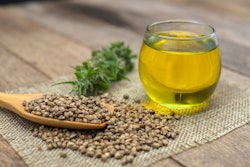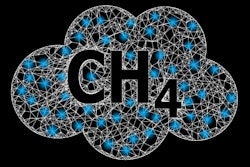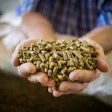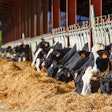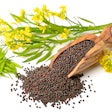
Gerardo Santoma of Trouw Nutrition Spain discusses how feed formulators can source alternative ingredients during a prolonged period of price volatility.
How nutritionists can find flexibility amid volatility (15:12)
Ann Reus: Hello and welcome to the Feed Strategy podcast. I’m your host, Feed Strategy senior reporter Ann Reus.
Today I’m speaking with Gerardo Santoma, technical manager for Trouw Nutrition Spain. We’re talking about how feed formulators can find more flexibility in sourcing ingredients while dealing with a prolonged period of price volatility.
Hi, Gerardo. Thanks for being here.
Gerardo Santoma: It’s a pleasure. Thanks a lot, Ann, to you.
Reus: Animal feed and other input costs have been high for some time now. How is this prolonged period of higher costs driving research on novel energy sources for animals?
Santoma: I would say that as it happens with prolonged high prices that we have had at home of both gas and electricity, we are now learning how to make better use of this energy at home. In the case of raw materials for animal nutrition, I would say that more than double the energy sources that we have, for instance, recently here in Spain, there have been the use of oil coming from the DDGs are being promoted. It’s a matter of knowing better the content and available energy for the animal for a more efficient use of raw materials.
In the sense, we recognize that, for instance, it was presented recently in the PSA (Poultry Science Association) conference in San Antonio, that between different batches of maize, we can have more than 200 kilocalories and much more in the case of wheat. So apparently, these are the fractions, different fractions of NSP (non-starch polysaccharide), mainly soluble and insoluble fractions. The solubility of protein are responsible for this variation, and a lot of research is being done in that area. Also, we see in soybean meal for instance, my colleague and friend Gonzalo González Mateos of University of Madrid has found differences between the sucrose levels of different batches that contribute more than 100 kilocalories between batches of soybean meal. So, safety margin costs a lot of money and the development of tools to try to decrease the safety margins are also important.
Another area that is being now developed in different institutions in England, France, in Australia in the USA, is to promote the use in poultry, the net energy in the same way as it is being used nowadays in pigs in order to be more precise, when we formulate diets. And in this sense, very important institutions for instance, also at the PSA meeting in San Antonio, Professor (Ryan) Dilger from (University of) Illinois presented the project of a national animal nutrition program to present a more precise estimation of the nutritive value of the raw materials. Other institutions in Europe, like the CVB in the Netherlands, INRA (National Institute of Agricultural Research) in France, and ourselves in Spain, our foundation are looking the same target.
And you have asked me about the energy sources but we can’t forget that here in Europe, we are very deficient in protein sources, and the EU is promoting a very important program in order to try to find alternative to the protein concentrates, to be not so dependent on Americans. And alternative protein, like pulses, legumes as well as soybeans adapted to local conditions here in Europe are being promoted in this way.
Reus: What research is going on to reduce diet costs while maintaining performance?
Santoma: Ann, I would say that more than performance, the key target in most animal products is the minimum production cost per kilo of animal product the very important required quality. A new respect for both pigs and poultry modeling is becoming and will become a key tool to optimize the feed cost for a determined product. But to develop a model precise enough a lot of growth trials must be developed with different nutrient levels as well as in different environmental conditions – temperature, stocking density, genetics. I like a sentence that Professor (Martin) Zuidhof from Alberta says, that all models are mistaken, but some are useful. We are trying to develop useful models. In the respect we see the recently that the breeding companies and animal nutrition companies are developing continuously genetic nutrition interaction trials to update continuously that responds to the nutrients in different environments. So, I would say that even these breeding companies are recommending in their lab recommendations a lower energy concentration of the diets. They are not looking for maximum performance, but they recognize that you have to decrease the production cost maybe nowadays this is important or is interesting to decrease the energy concentration of the diet.
Apart from this, Ann, it is quite remarkable that the research undertaken in recent years about the role of fiber in monogastric nutrition, which is helping us in the better use of nutrients. When I was a student, fiber was an antinutritional factor and nowadays, we have reached an idea that of the important role of the different fiber fractions, mainly the soluble and insoluble fraction for a proper digestive tract development in the poultry as well as the proper microbiome development, both in pigs and poultry. Also is important, the feed technology regarding pellet quality, as well as particle size because of their influence on digestibility and performance of the animals, which is also very relevant, of course, and talking about the quality, not only the minimum production costs, we see that the recent development of genetics have had some negative side effects. For instance, in poultry we have the myopathies or bone problems or in poultry, more pathological problems because of the an insufficient immune development.
So meanwhile, the genetic development counter these side effects. In nutrition we try to help to accompany this process developing nutritional strategies to accompany these processes. For instance, extra high levels of vitamin D a day continuously up to five days development, the calcium and digestible phosphorus requirements and also different antioxidants, different energy concentrations at different stages of broilers to improve the problem of the myopathies. We are trying even to delay a little bit to slow down the growth of the birds in order to prevent these myopathies.
Reus: What are some ways to procure local, alternative ingredients, and do those work to achieve cost savings?
Santoma: Yes, I would say that the most practical way is to use the co-products that come from the food industry. Nowadays, for a sustainable animal production that I know, from your magazine, it’s becoming more and more important in feed formulation in the different companies around the world. And now, we are talking about circular economy that those of us that are working in animal production know for a long time. So, I would say that in this respect the feed industry is at the forefront of the use of co-products like bakery byproducts, pulp from the sugar industry, the fats and oils coming from the rendering industry, all cakes in the end coming from the oil industries, they are co-products. And also milk industry, the cereal industry, the brans, middlings, hulls. So a wide range of co-products are being used in feed. In Europe, they represent more than 15% of the of the feed. So this is a very important issue.
Another way to procure alternative or local products, as you know, is the development of the insect production. I would say that in some countries of Africa, where Trouw Nutrition collaborates, these developments are being step-by-step implemented. In Europe nowadays, this source or the insect production is very scarce or not available at a reasonable price for pigs and poultry or livestock. But nowadays, it comes mainly to pet food and to aqua. But in the end this is a matter of economy of scale. It’s in the future that industry of insect production develops can be usable source also for pigs and poultry, let’s hope.
When we talk about use local products, we are talking about also the use of products produced locally and also is a very important issue. I would say there are several companies including ourselves are proposing the use of platforms to study different scenarios of environmental impact of different feed formulation strategies in pigs and poultry in order to look at the these sustainability scenarios using local products.
Reus: What are some other creative and innovative ways feed formulators and nutritionists are finding to reduce costs for animal diets?
Santoma: I have said something when talking about how the breeding companies especially in poultry, but also in pigs are even recommending to decrease energy. We have implemented that into practice. We are formulating diets with lower and lower nutrient concentration because of the high cost of both energy concentrates, most of cereals, fats and oils as well as protein concentrates. They have become more expensive relative to other raw materials like less concentrated cereals, rapeseed sometimes, palm kernel, sunflower meal. In this sense, we have recently, a couple of years ago, even included wheat bran in broiler diets. It was a material we used before in say breeders or layers. But now even in broilers and with very good results on performance cost.
Besides, we know of course on the we are in a time where the use of antibiotics is fortunately, because of the problem of antibiotic resistance, decreasing and old research devoted to intestinal health favors a better digestion and availability of the nutrients. As you have collected in the Feed Strategy edition of March, the production of antibiotic-free feeds is one of the main issues for nutritionists all over the world. In this respect, management conditions of animals, water treatment, and the use of additives is helping a lot. I would say that nowadays, Ann, we are in a golden age of additives. Why? Because the return of investment has increased, because of the high increase of raw material, higher than the relative cost increase, of course of the feed additives. So the ROI is increasing. So a lot of research, as you know, you published in your journal is being devoted in this area.
More recently, more and more phytogenics. So when developed with different synergies among them, as well as ways of encapsulating them in order to reach the distal part of intestine to play different roles to play in intestinal health mainly, let’s say, to decrease inflammation, to establish a better barrier or gut integrity. So, I see that we are looking at the change of paradigm when talking about intestinal health. We come from the time through the antibiotic strategy, where we were looking for an intestine free of microbes, to a strategy which looks for an alliance with the commensal and good microbiome, the animals and also humans have in the intestine to have a more resilient intestine against pathogens. So, something similar can be said apart from phytogenic from other kinds of additives like probiotics, prebiotics, organic acids, protecting them in order to reach the proper part of the intestine. And further development I think is expected also in the area of phytases and there is a continuous evolution of more active phytases, proteases, carbohydrates, these activities to decrease the inflammation and which is very nutrient consuming, and better digestion also.
Reus: What trends in precision nutrition do you think we’ll see throughout 2023?
Santoma: Well, I have already mentioned some ones like modeling. Keeping a little bit on this whole concept, we some time ago, we had the opportunity to be for instance in Canada with Dr. (Candido) Pomar, who is doing a lot of research in precision feeding with different feeds in growing pigs in Canada. And INRA, also in France, some including sensors to have a more precise estimation of the requirements of the animals and in this way to have a proper mixture for instance to feed to adapt to the decreasing needs for instance of amino acids as the animal grows as far as requirements.
As far as evaluation, I would say that the NIR (near infrared) technology is able year after year to be more precise and more able to determine more sophisticated parameters like available amino acids. Some other attempts have also been done to estimate the energy content. So, we are seeing both in development in feed evaluation and nutrient requirements of animals are in continuous research.
What we know is that the genetic development anyway is continuous and influence of the interaction of both the genetic and nutrition and other conditions is very important. For instance, I am honored to be the vice president of FEDNA, the Spanish foundation for the development of animal nutrition in Spain, that every year we celebrate a conference with more than 800 attendees and which is becoming more and more international, there is also English translations not only in Spanish. So, we have devoted several sessions to the interaction of nutrition between nutrition and different elements of animal production, environment, sanitary conditions, management that helped to produce even better models.
Another interesting area I would say is that we are taking from cows, is coming from a static to a dynamic nutrition. How to put an example of what is dynamic nutrition: In human nutrition, we have the concept of glycemic index which means what is the rate of absorption of glucose in the intestine. So the same applies in animal nutrition for different nutrients like can be protein amino acids, even fiber, because it is becoming important the rate of absorption of the different nutrients in order to have a balanced absorption to have a better efficient and a better growth. And in the end, what we want this better cost of more sustainable production of our meat, milk and eggs and aqua.
Reus: Well, Gerardo, thank you for these interesting insights. It was great to have you on the podcast.
Santoma: Thanks a lot to you, Ann. It’s a pleasure to be here.
Reus: And thank you to the audience for listening. I’m Ann Reus for Feed Strategy.

